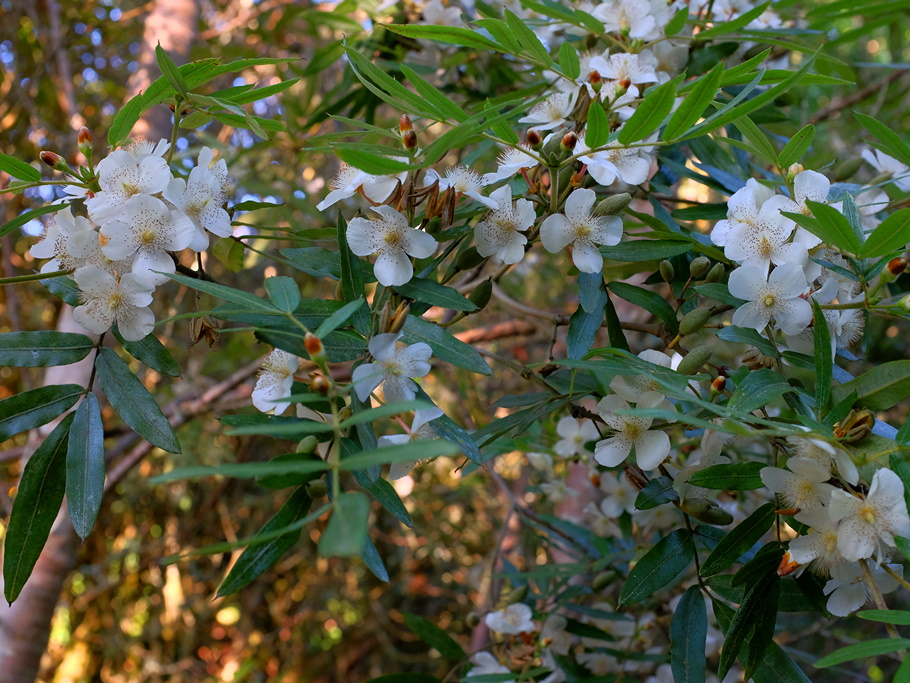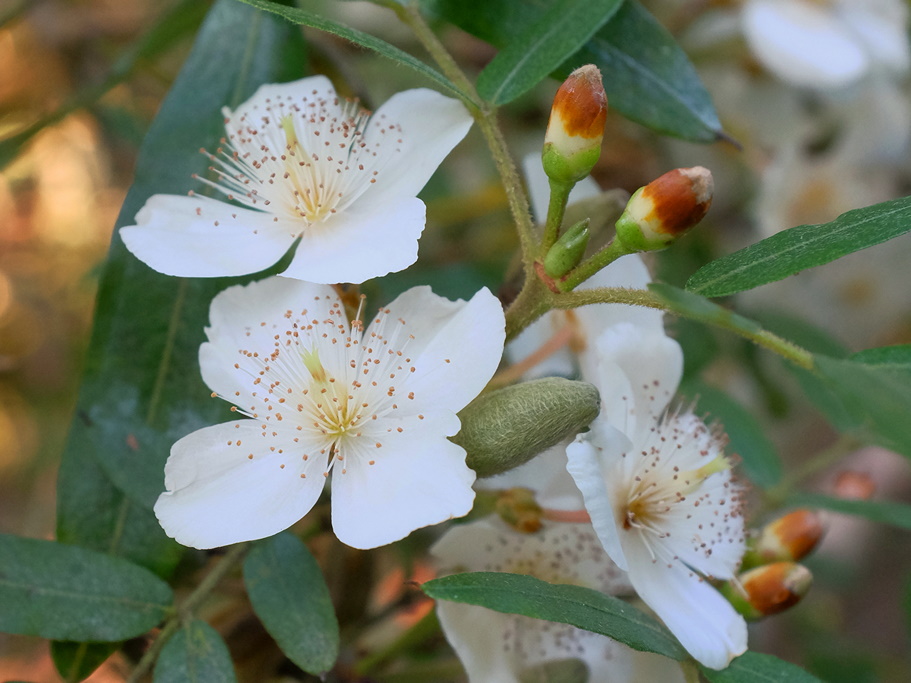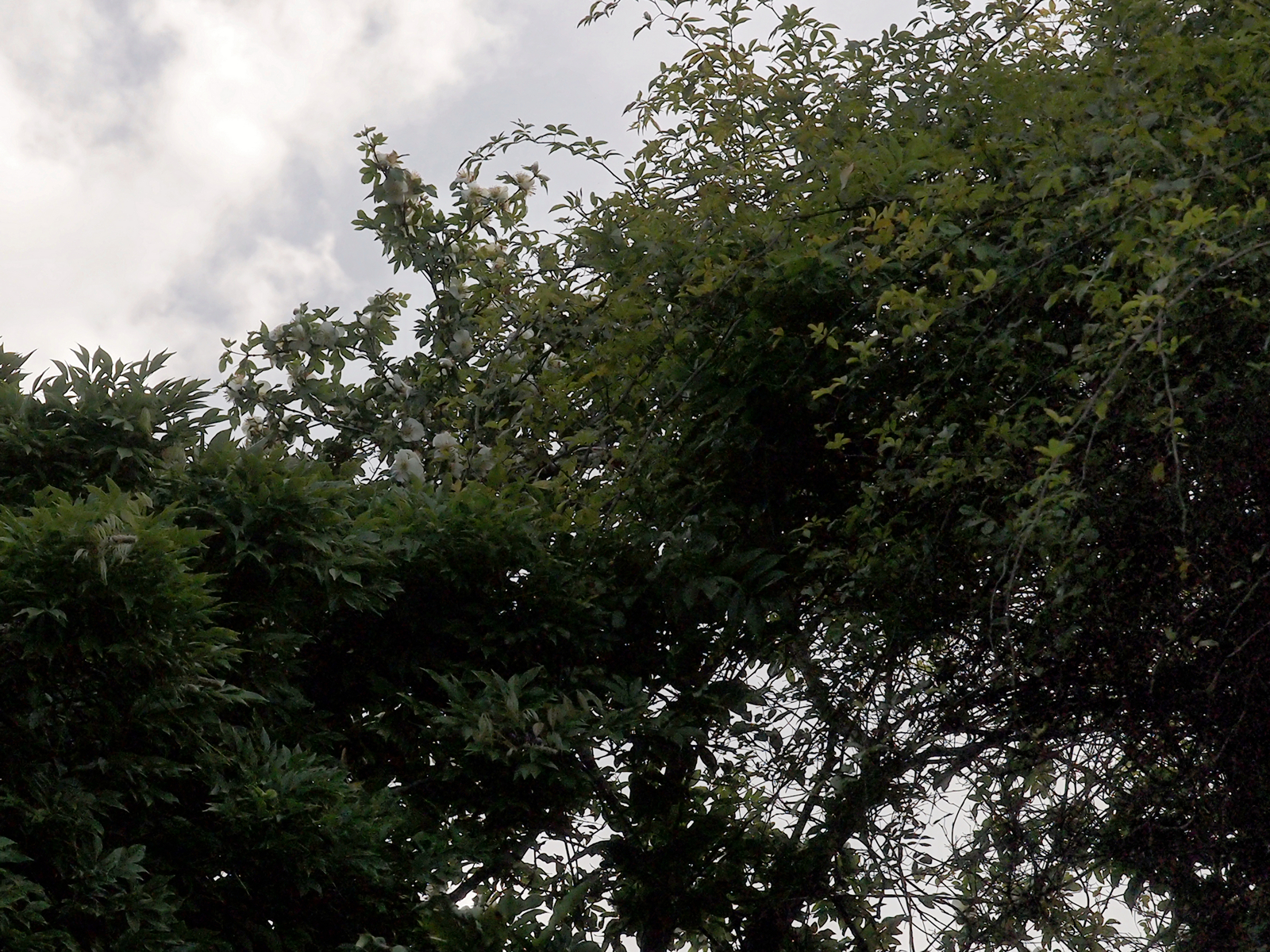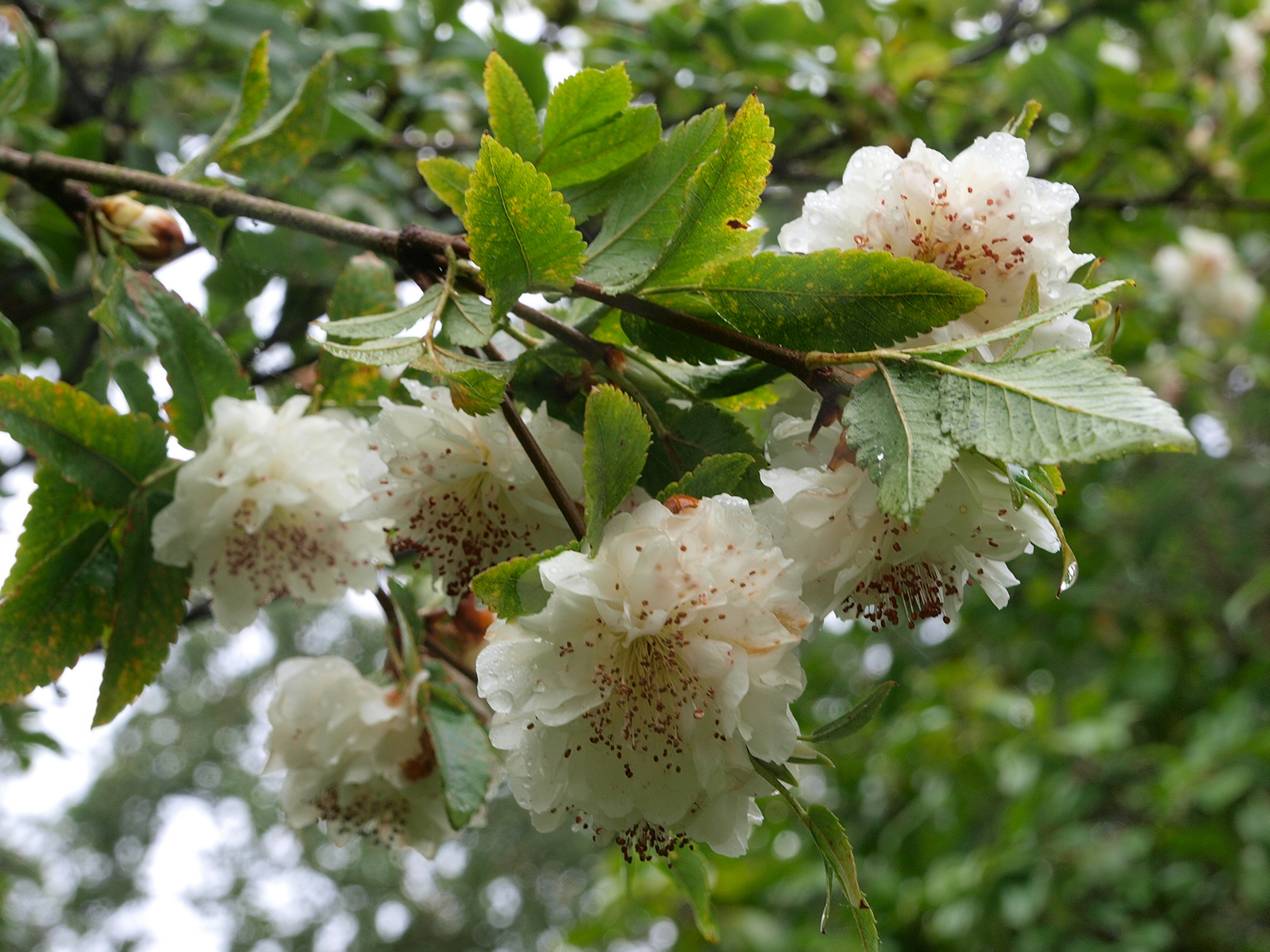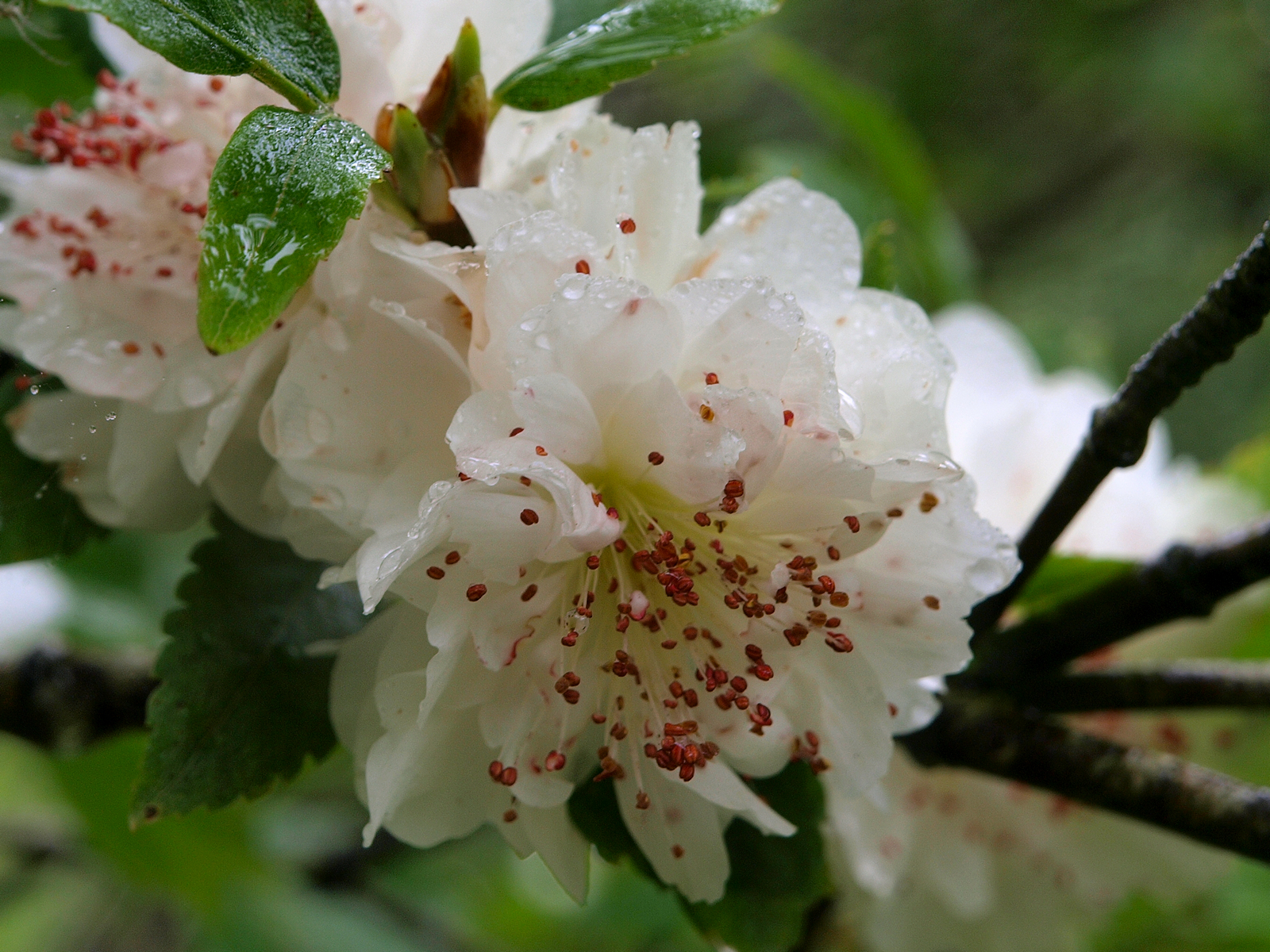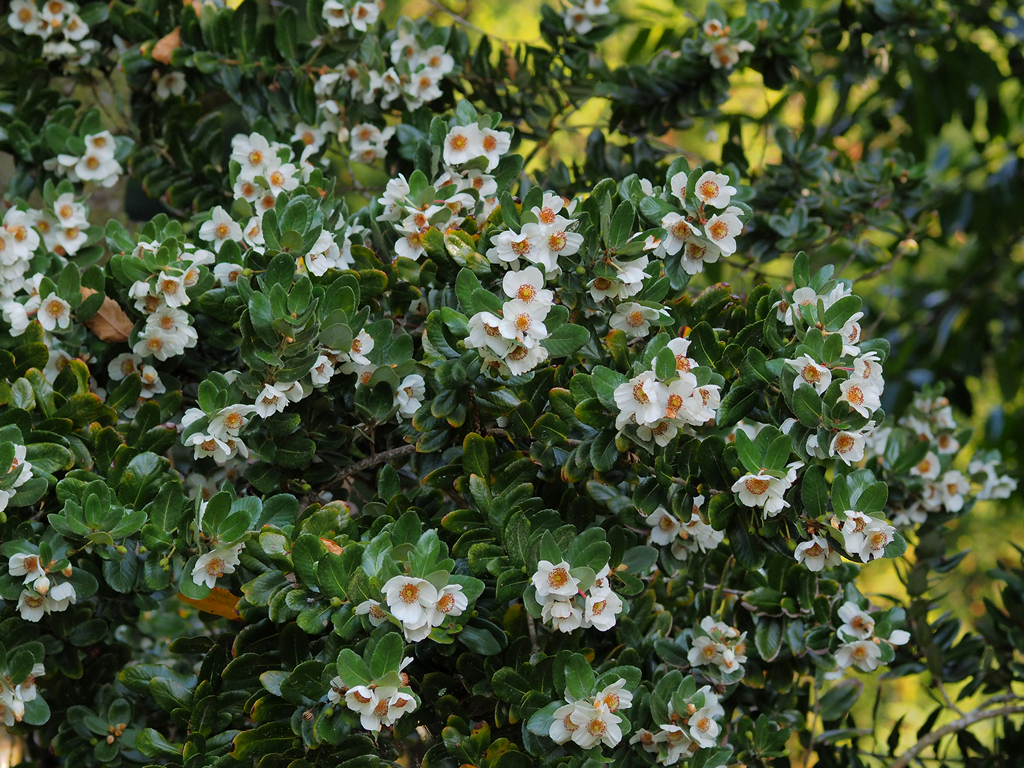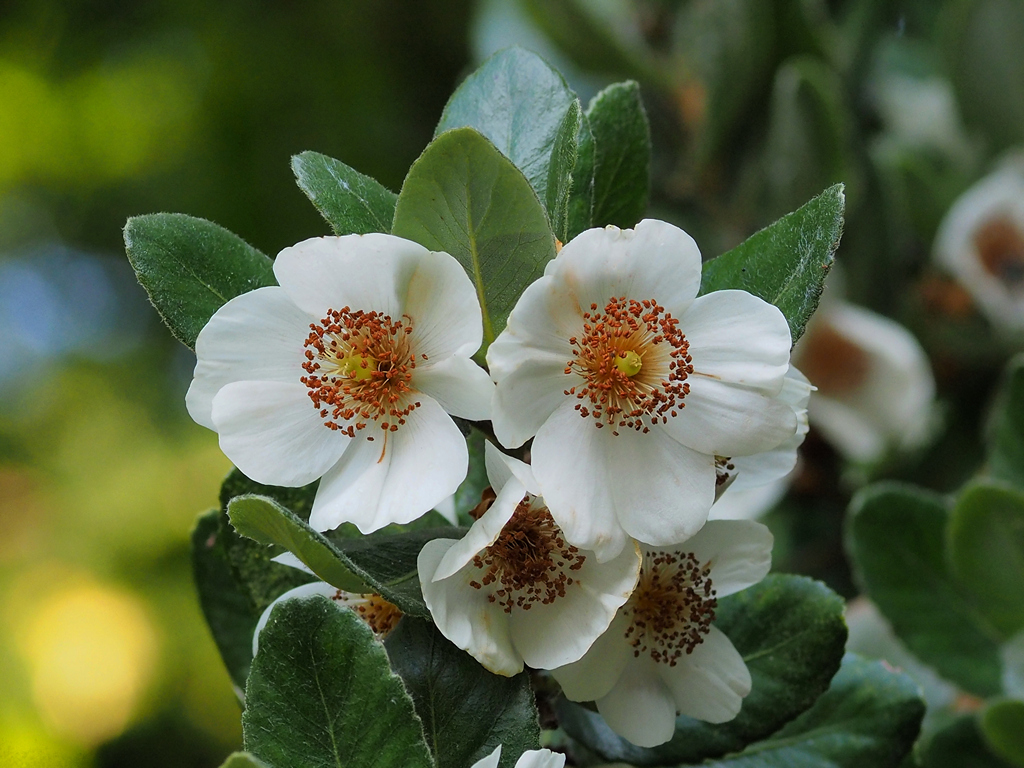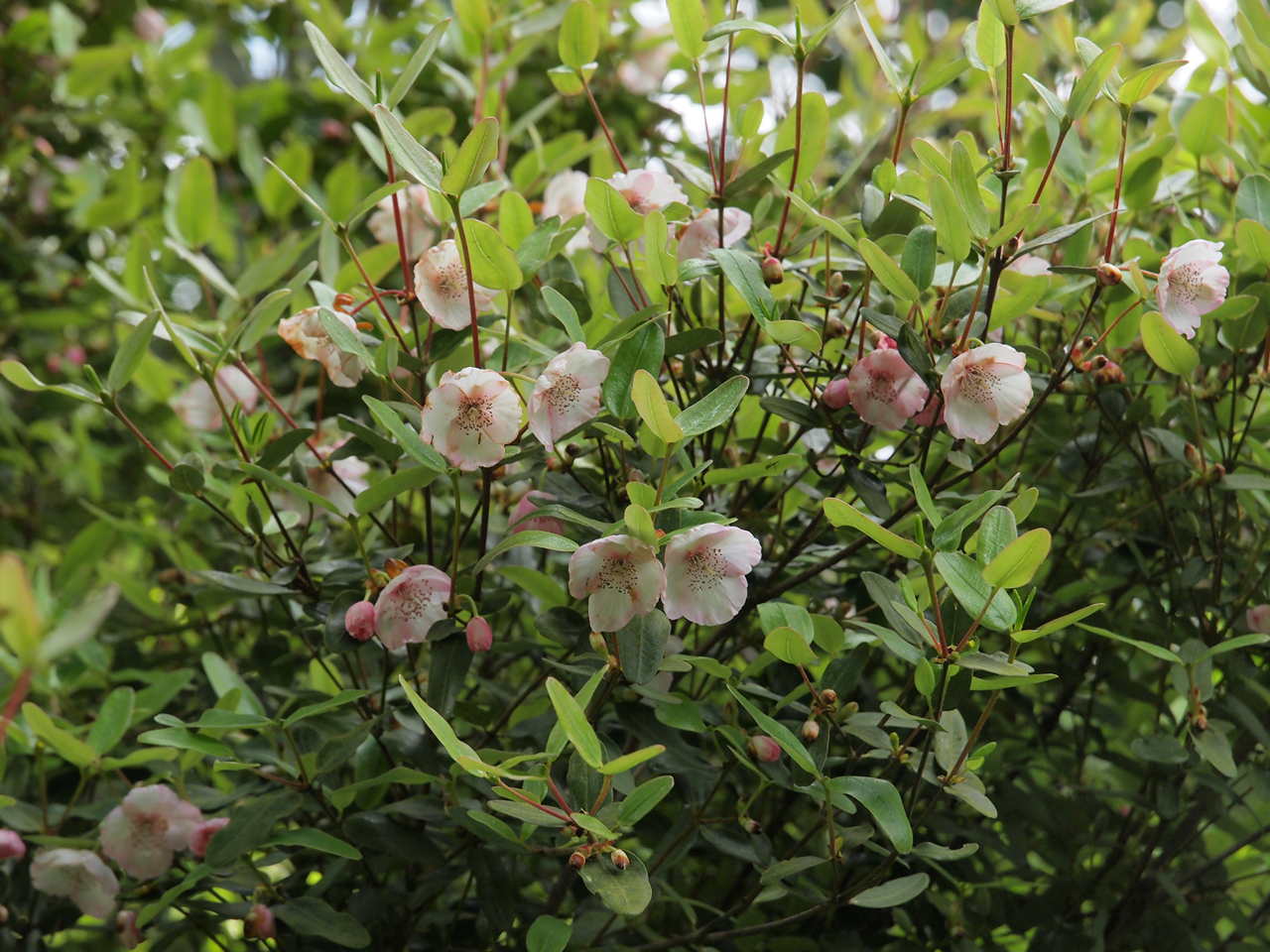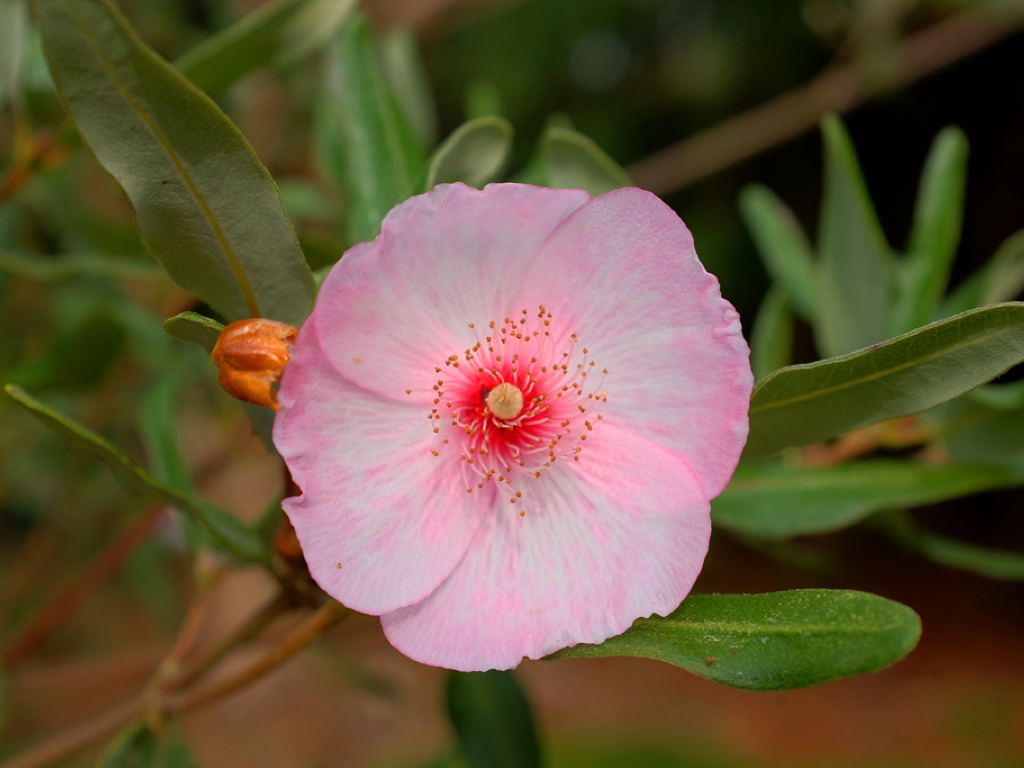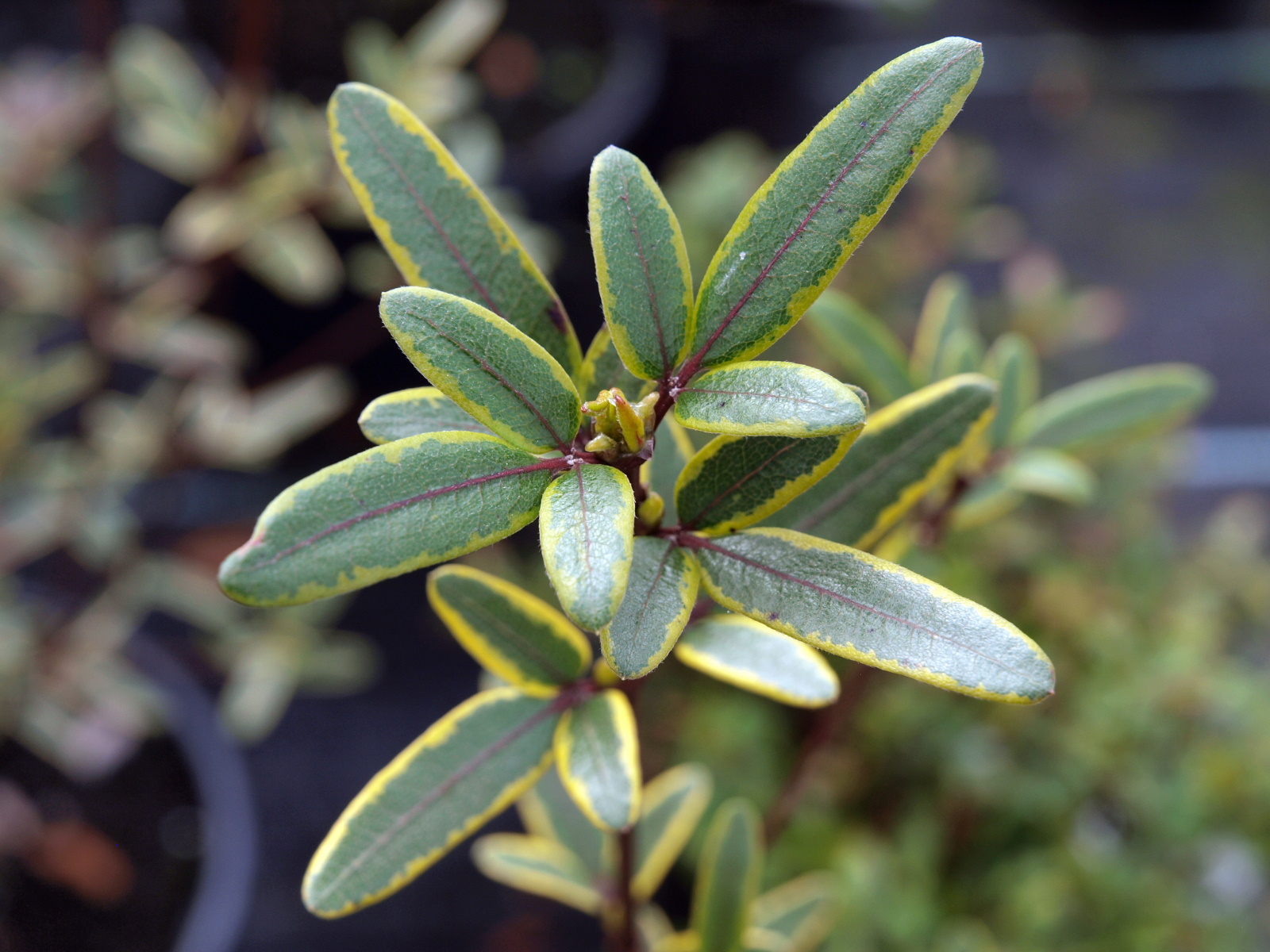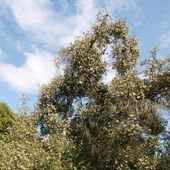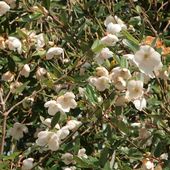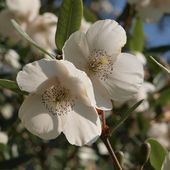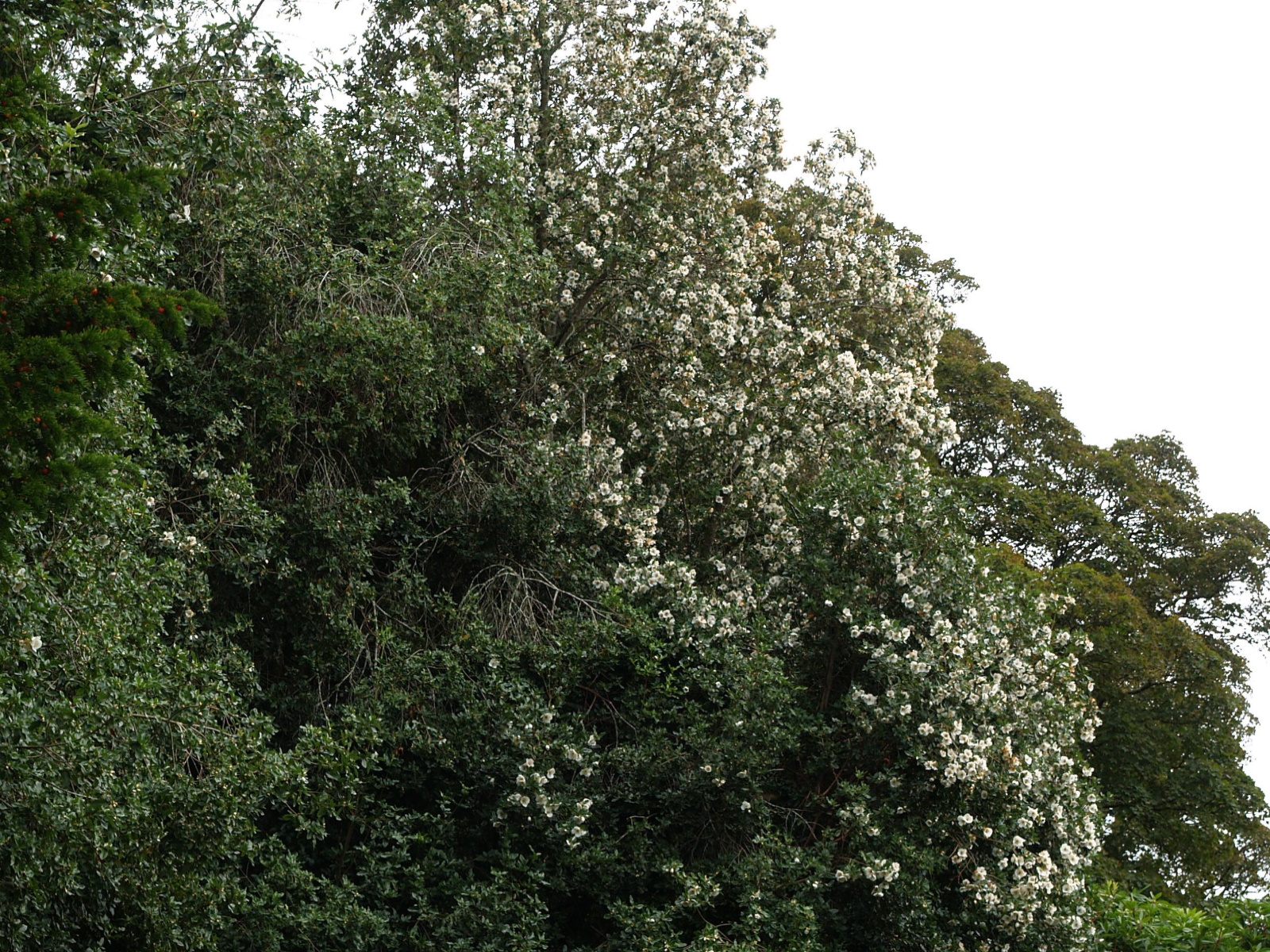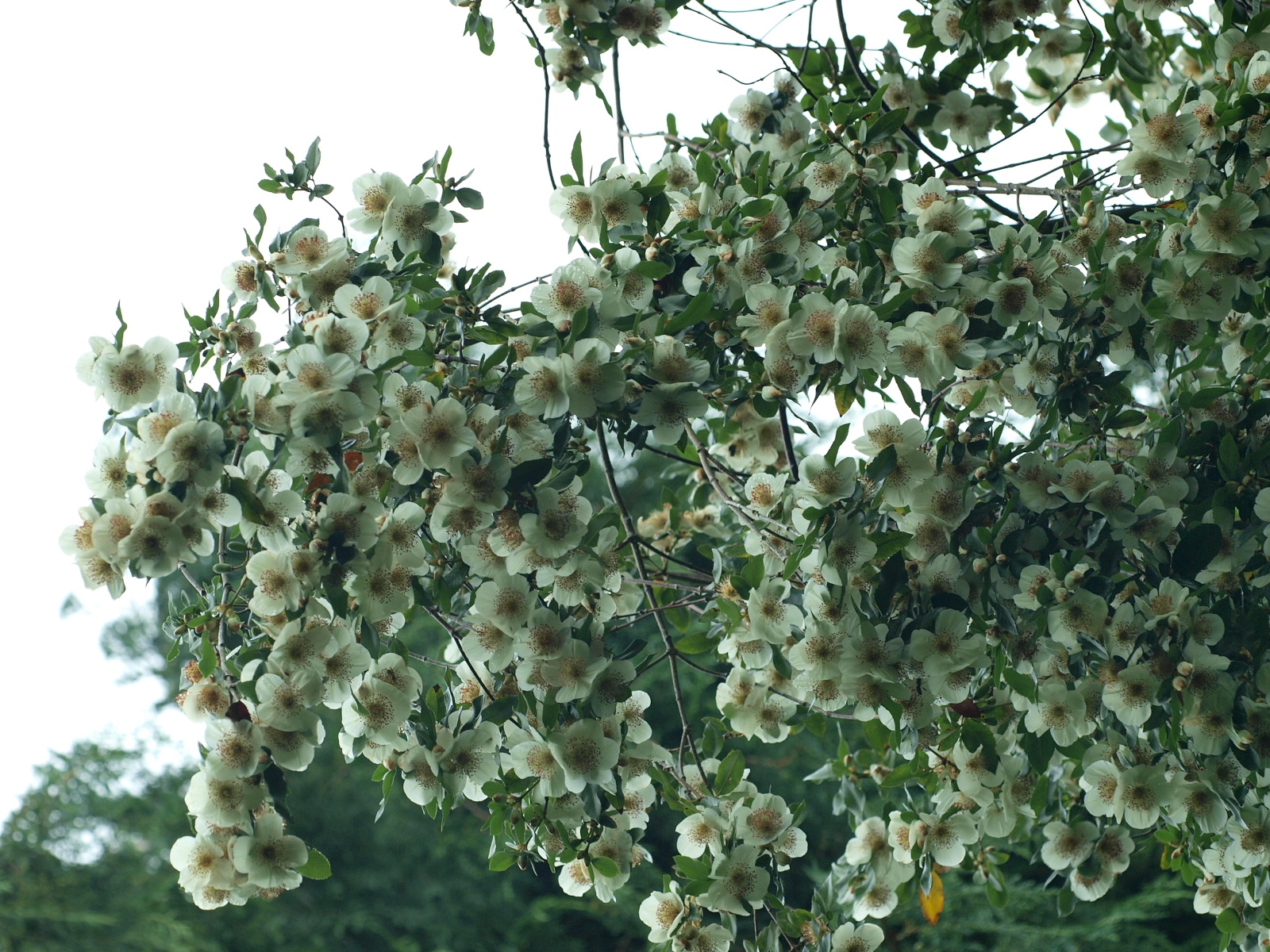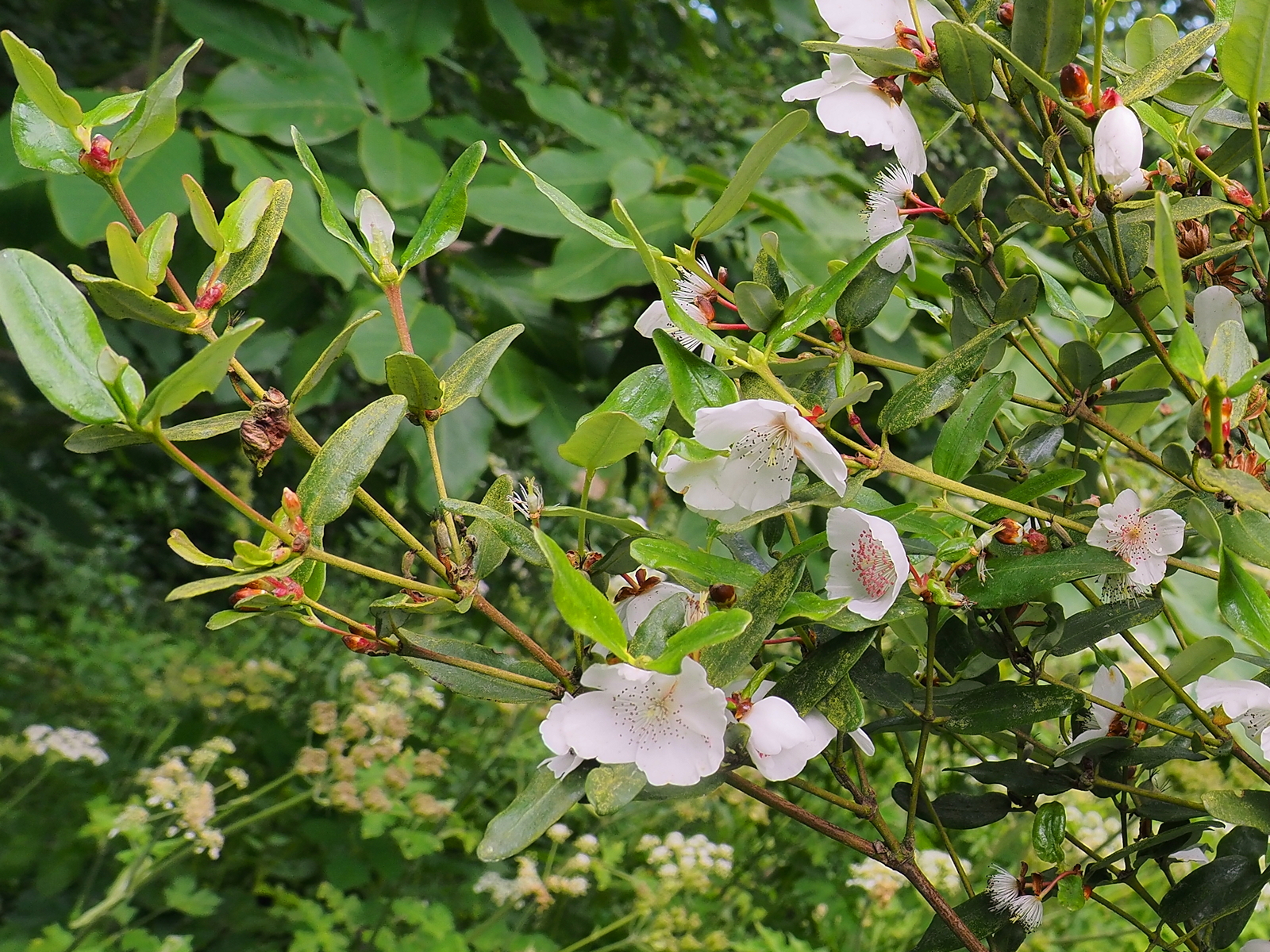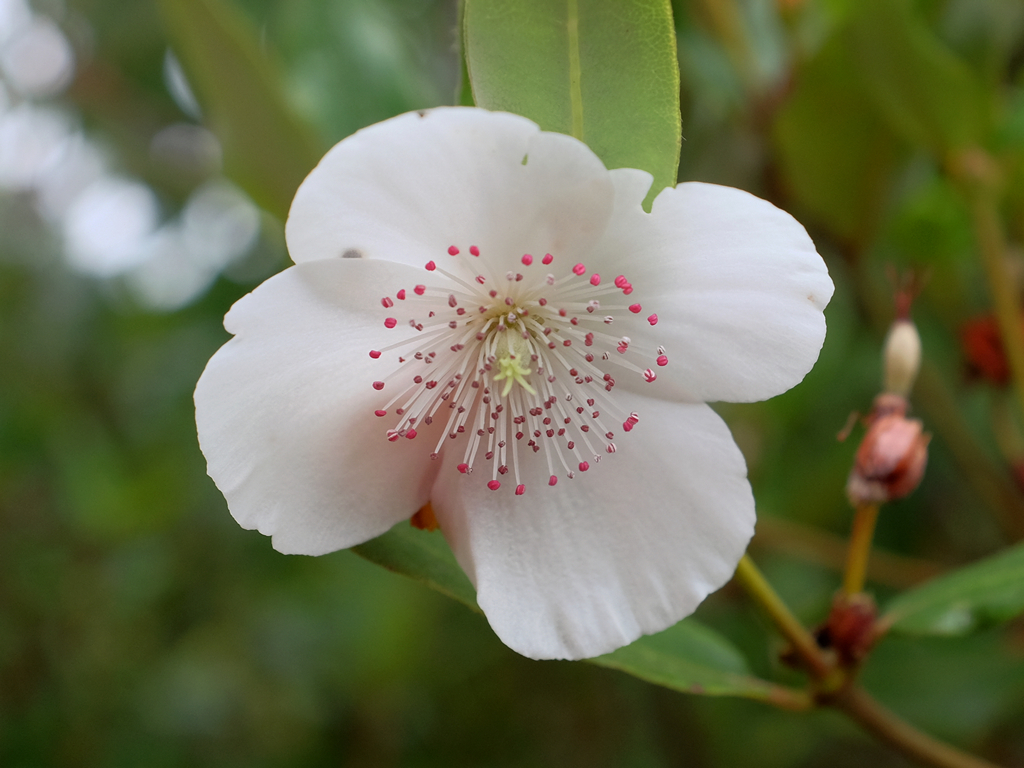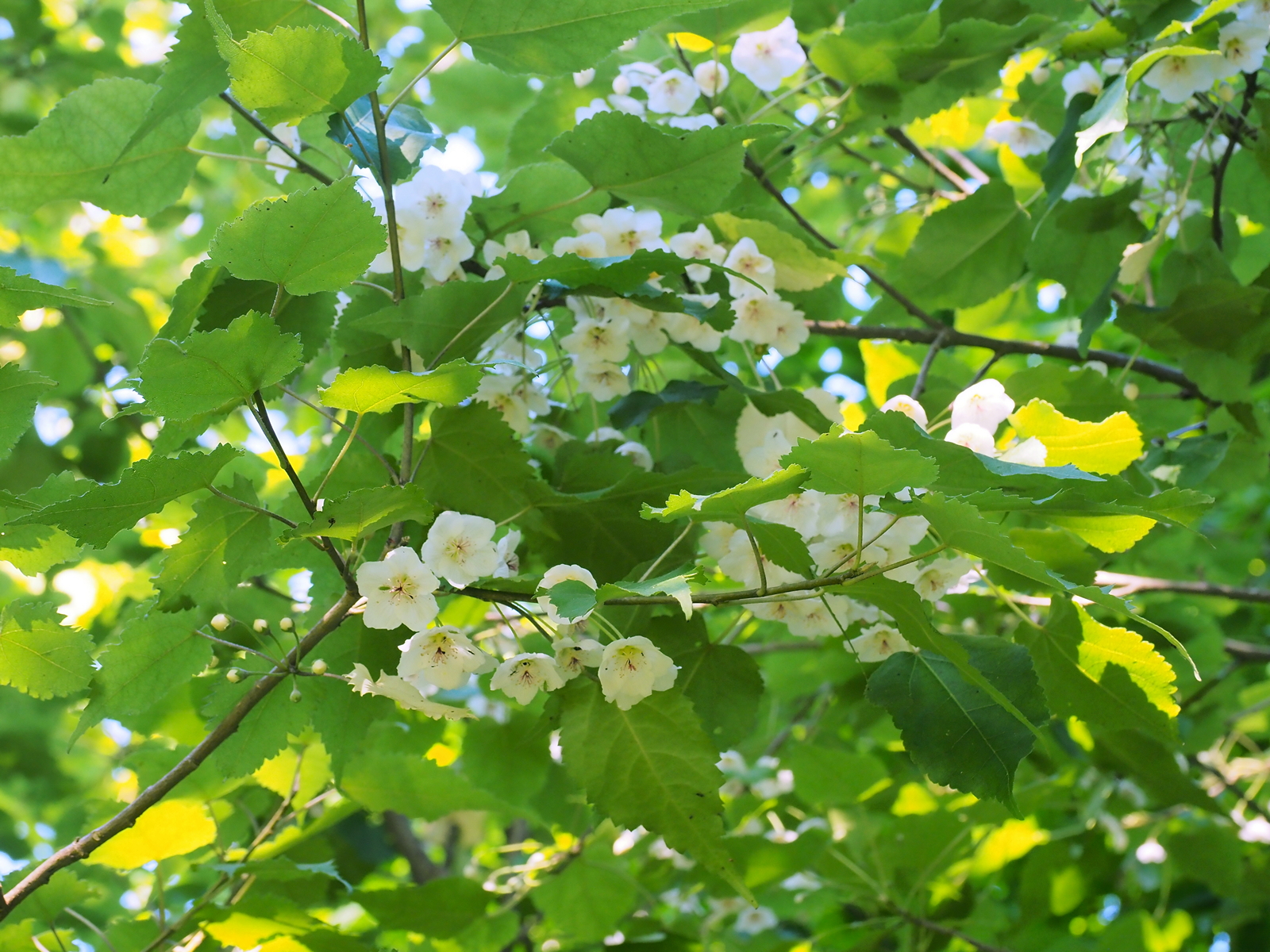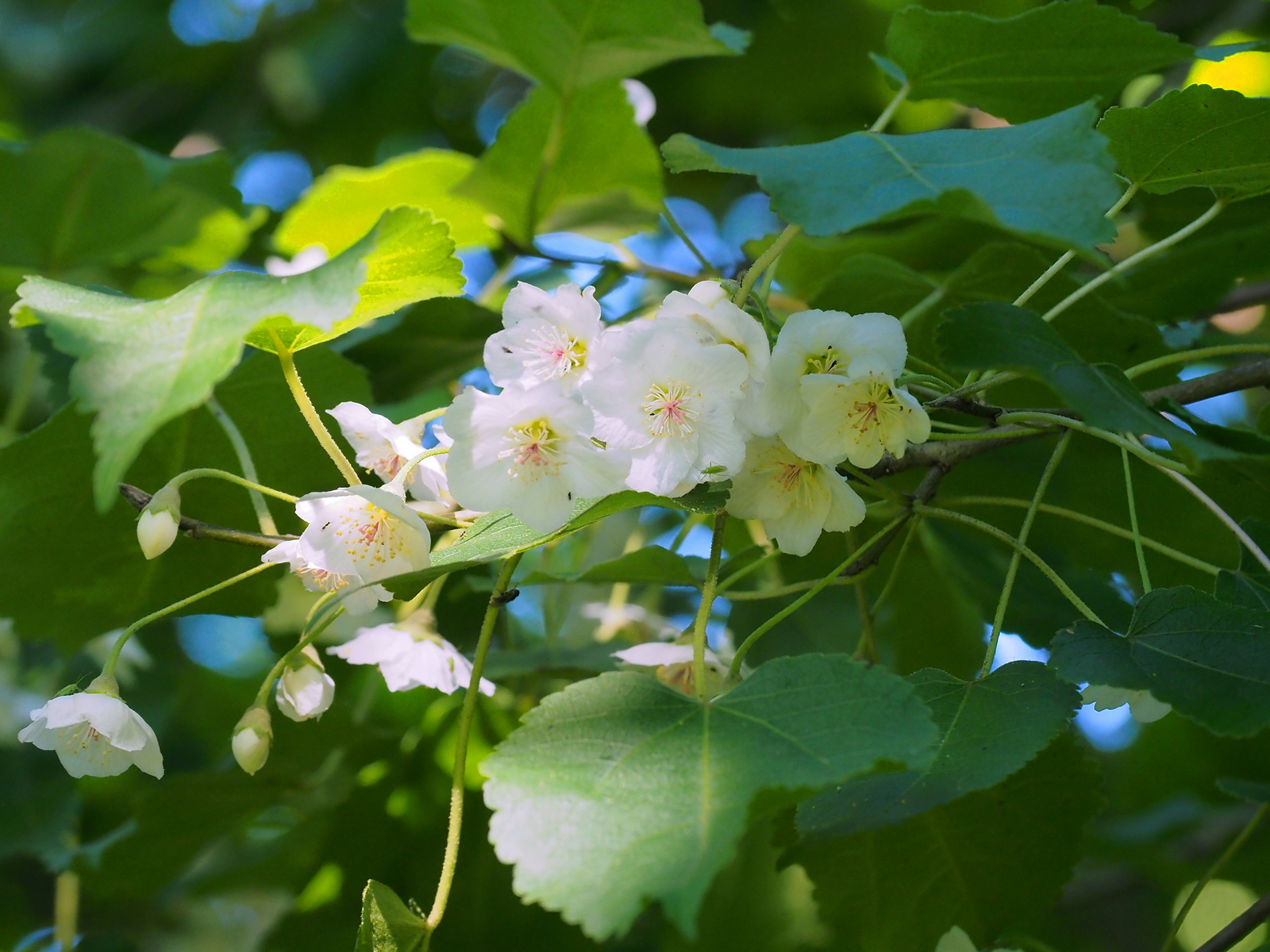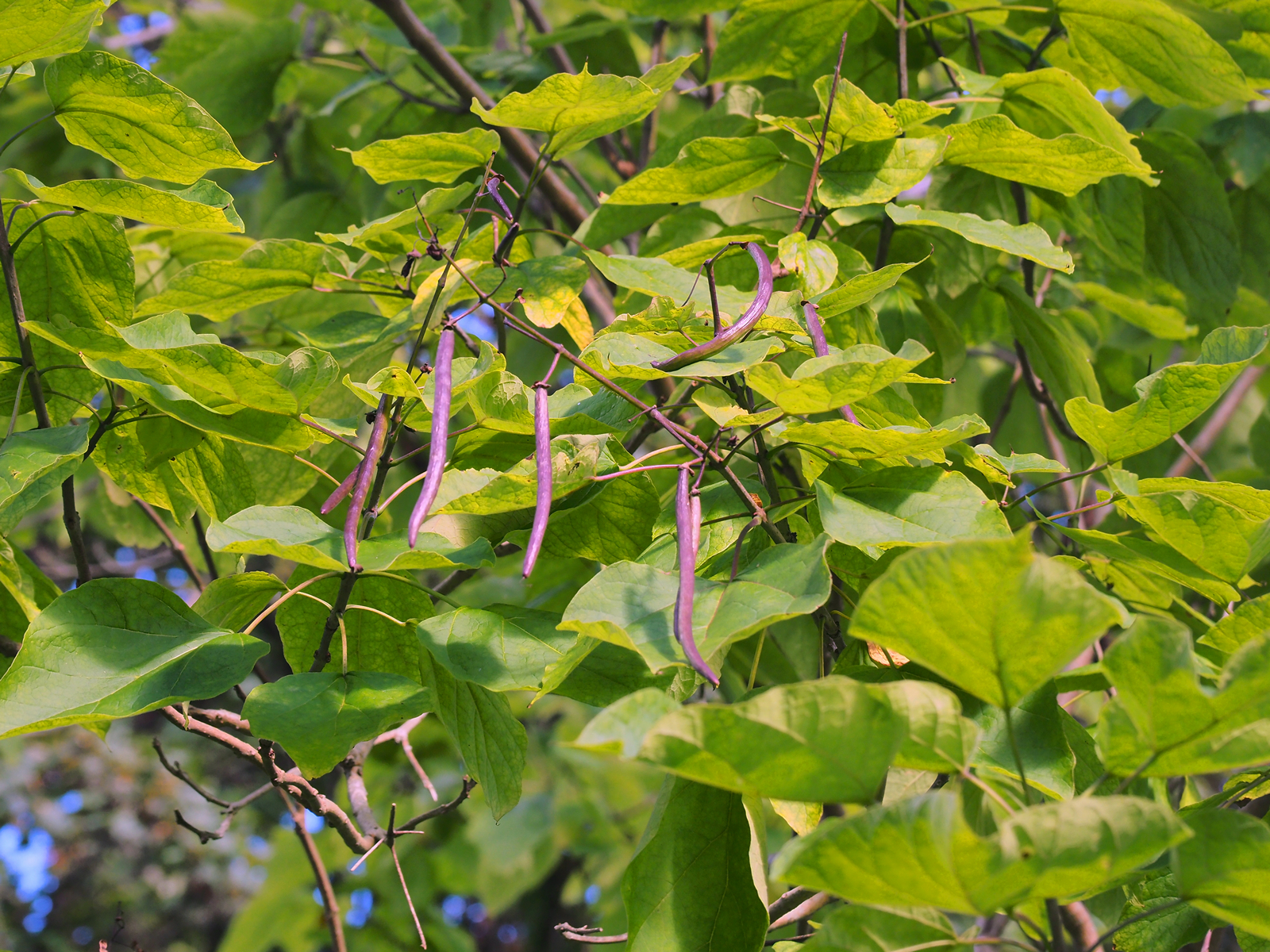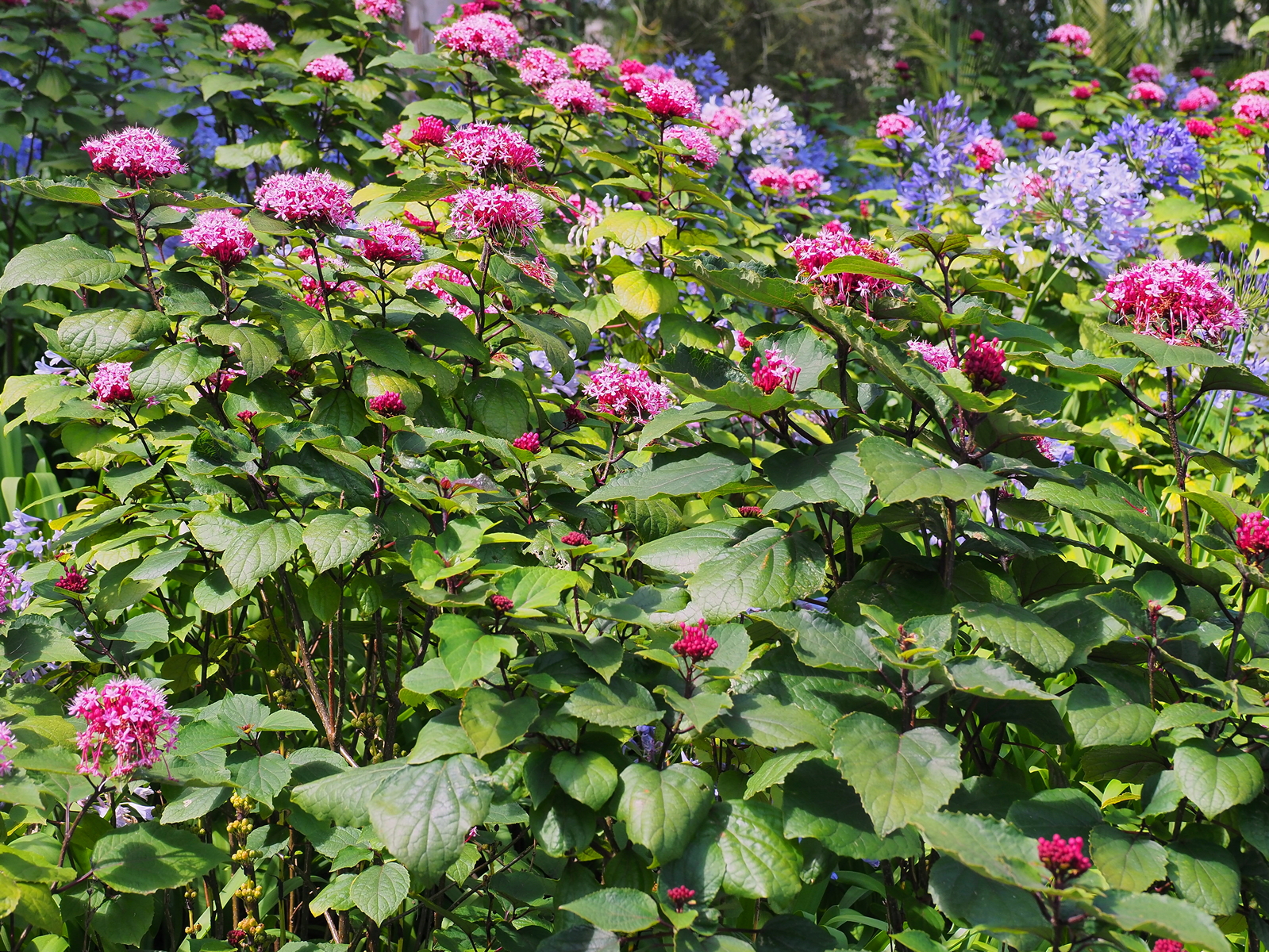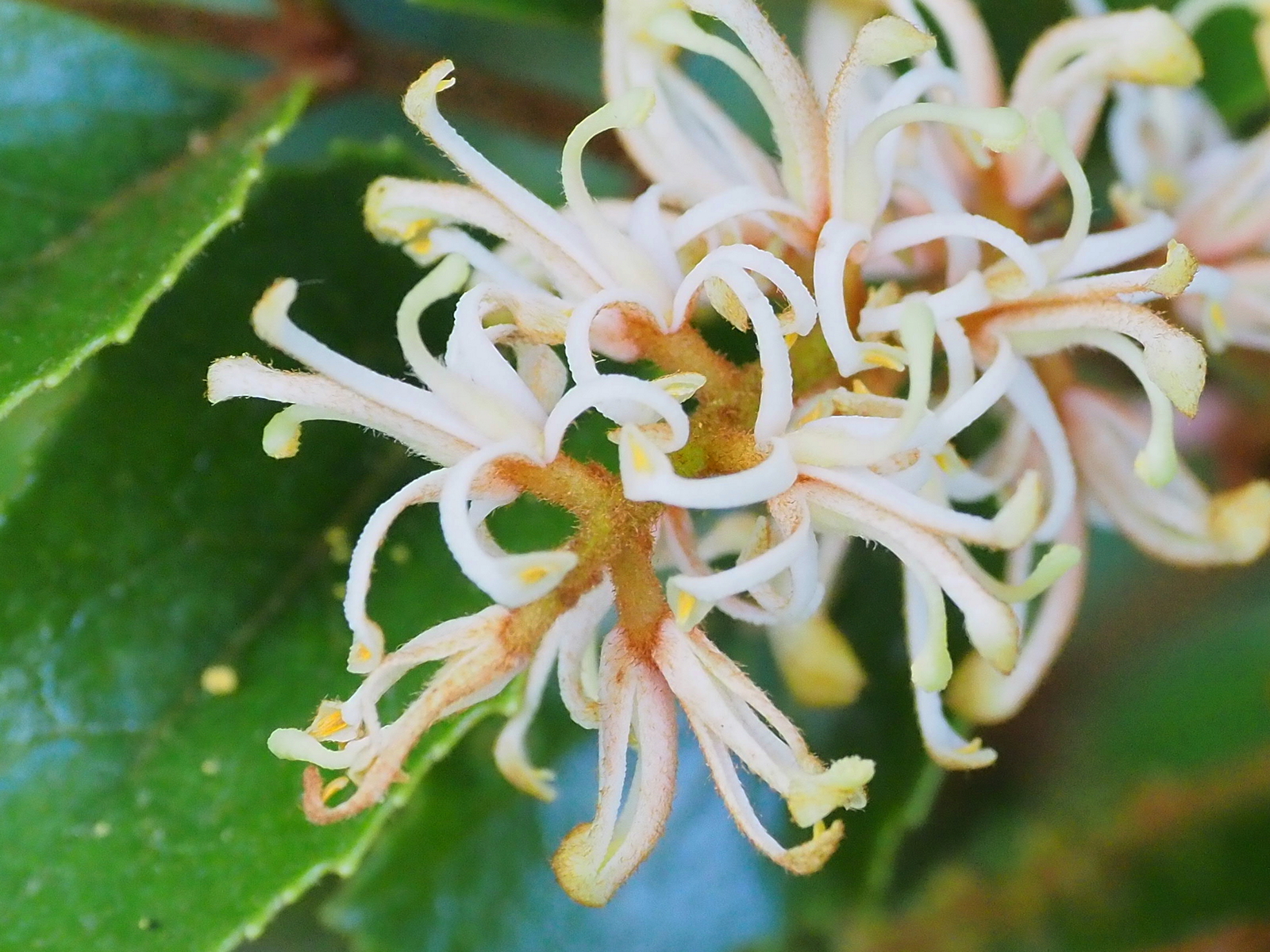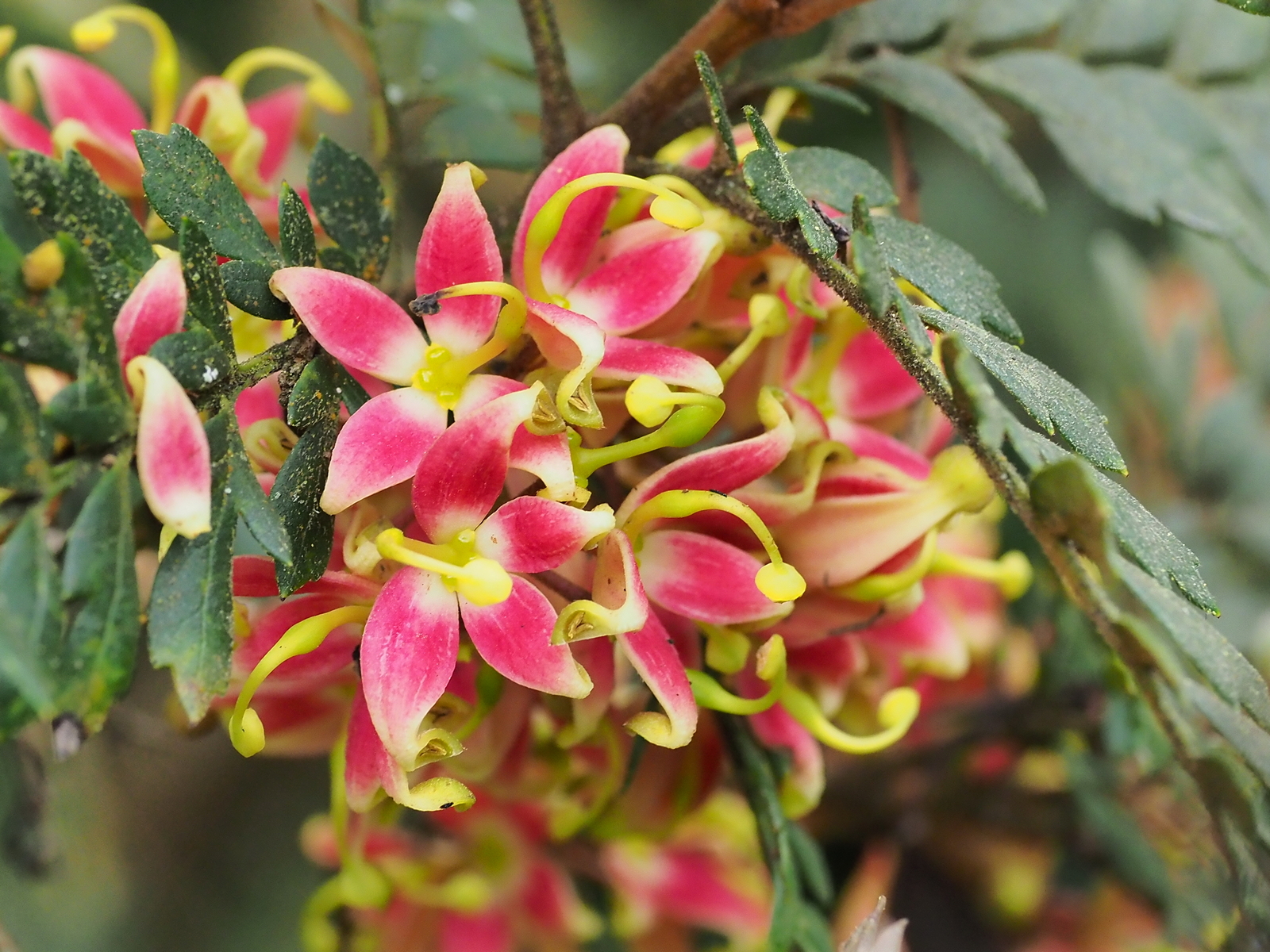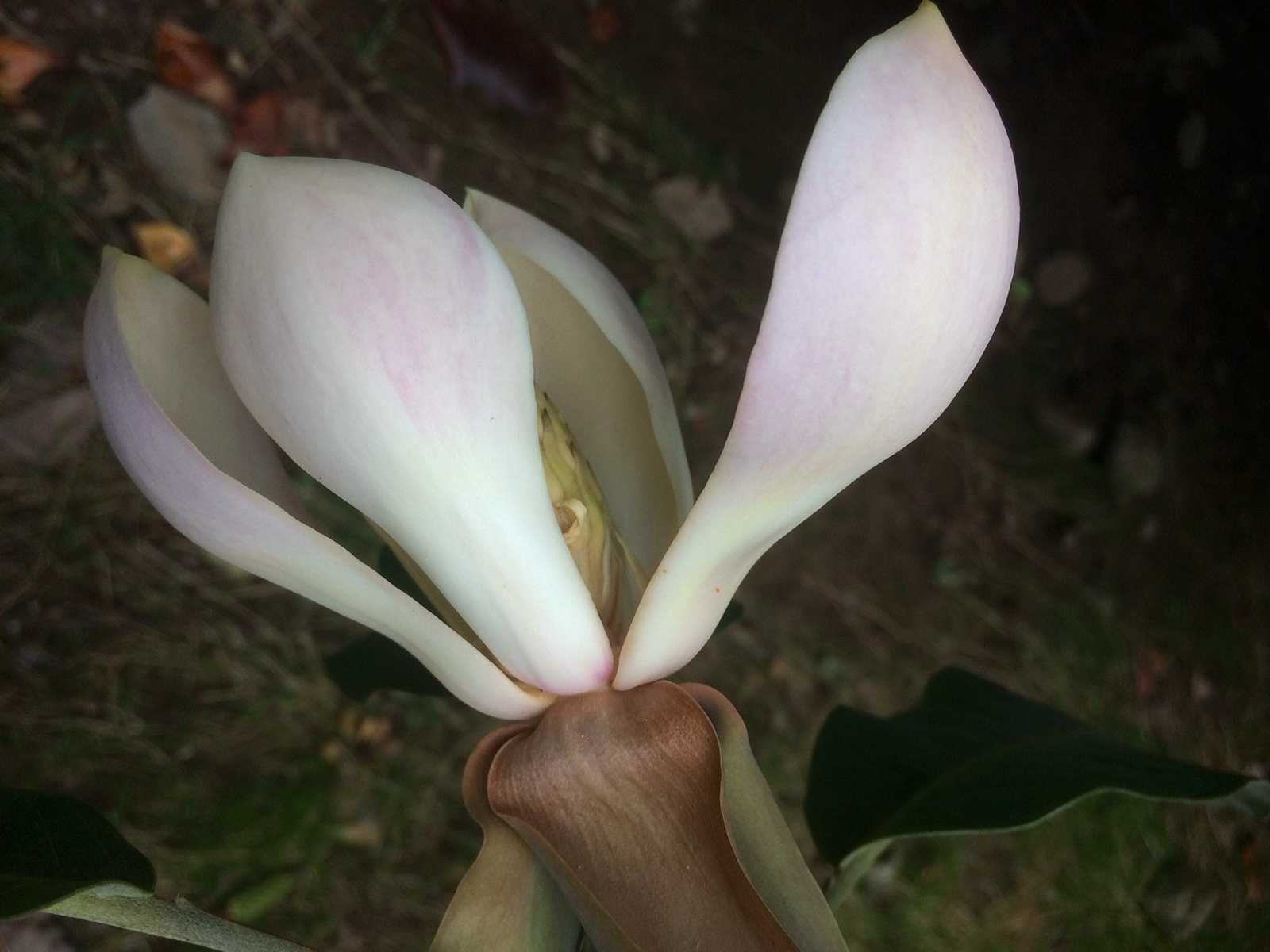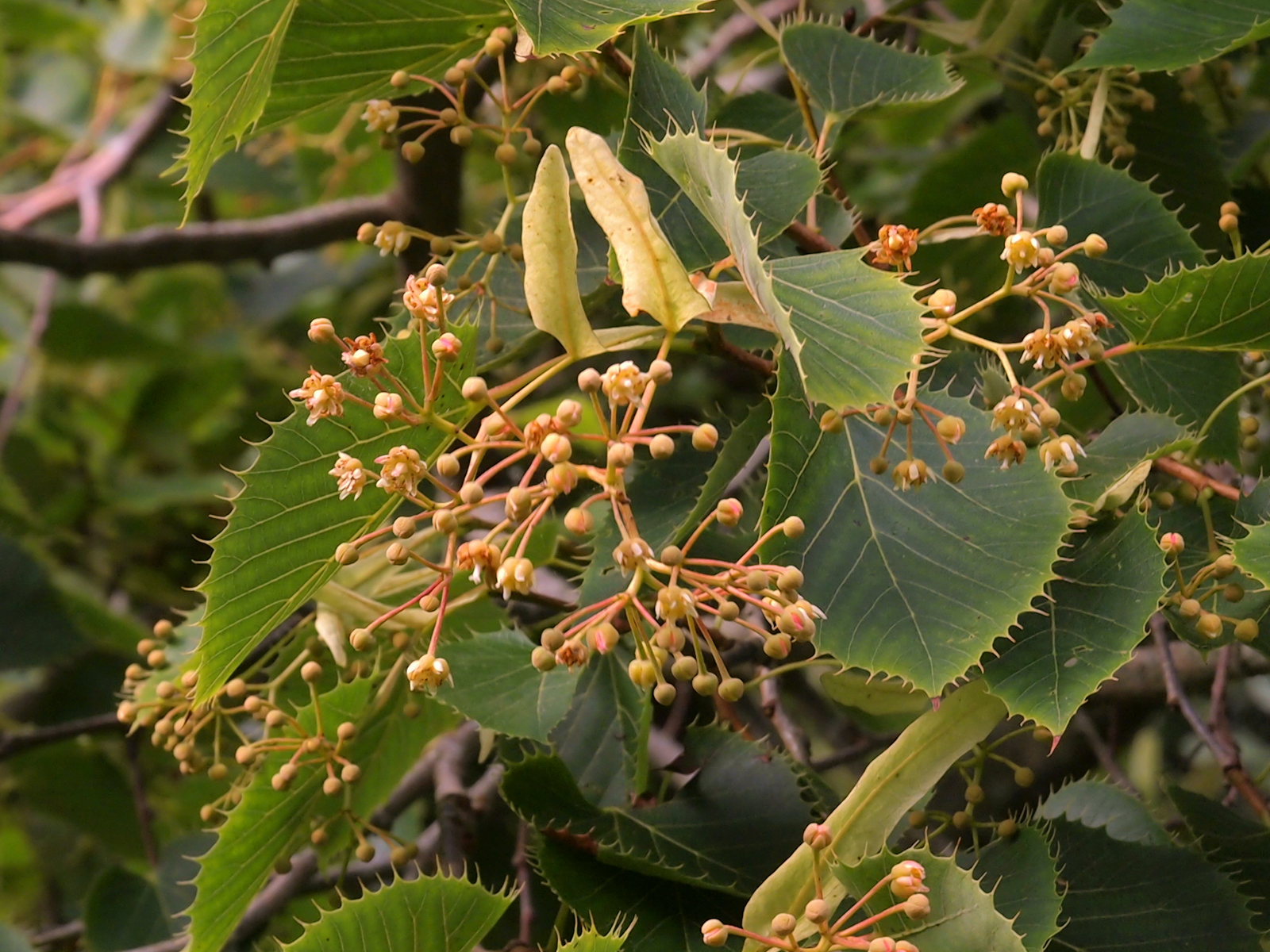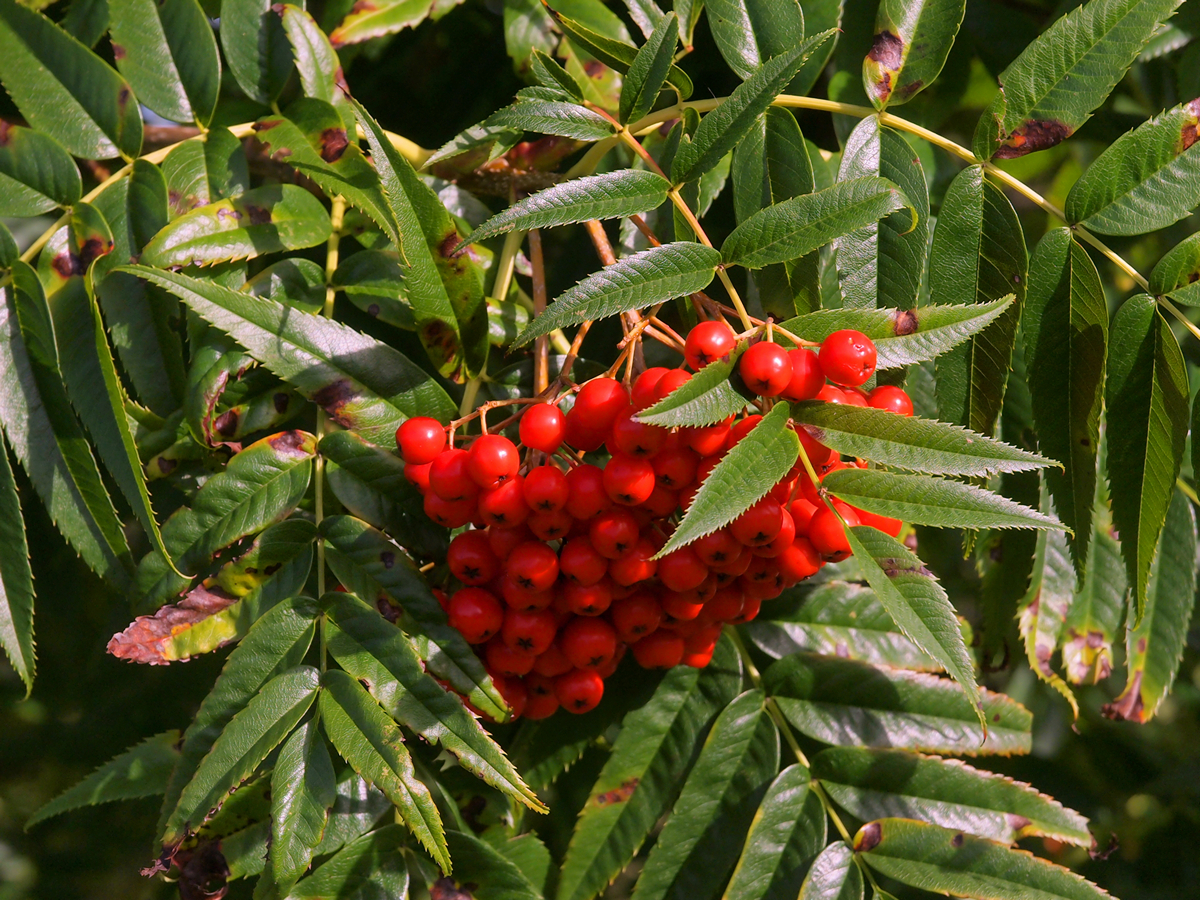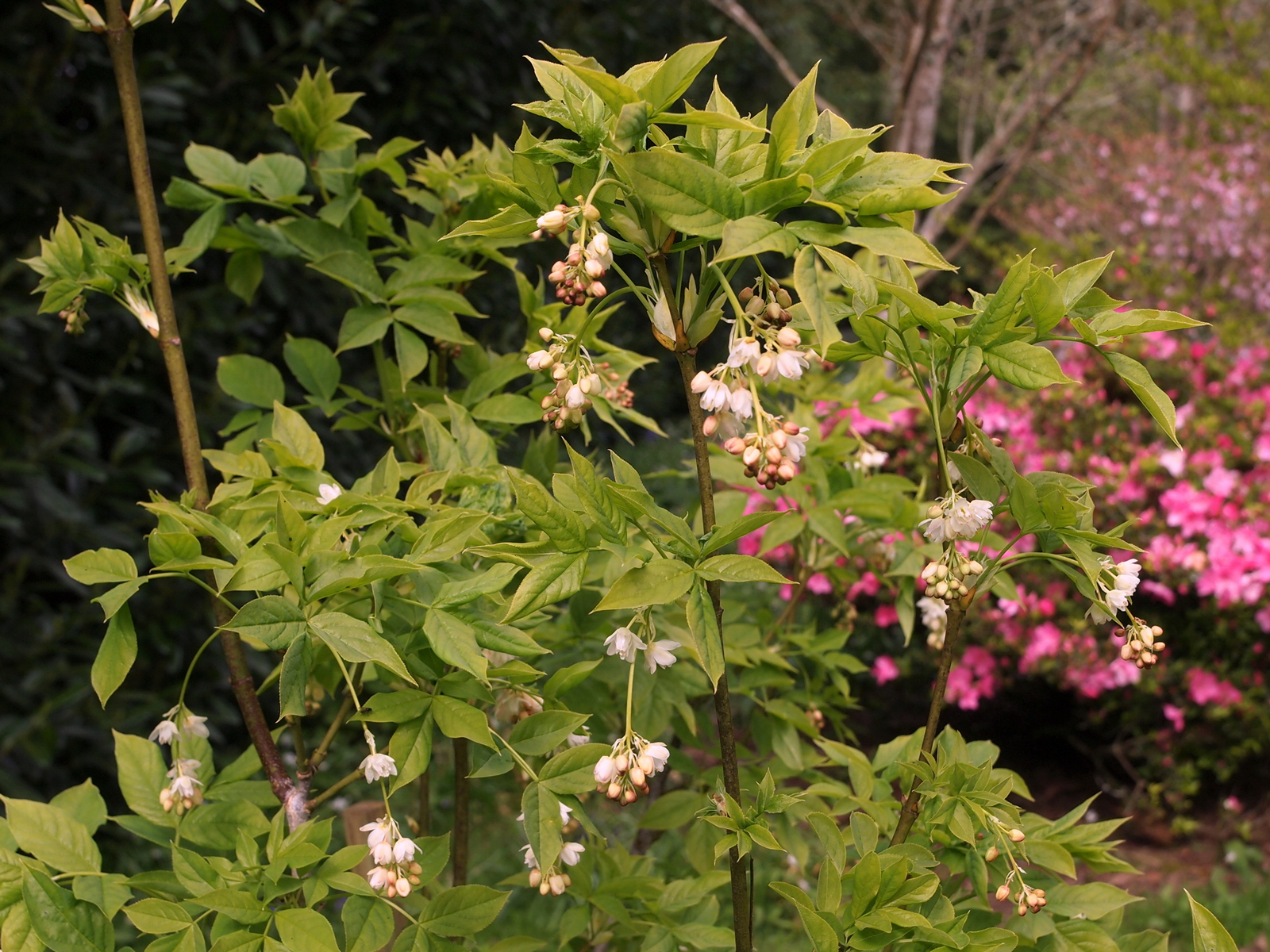Eucryphias
and other summer flowering trees in a woodland garden
RHS Recommended lecture at Burncoose House by Charles Williams in 2012
Cornish woodland gardens are deemed by many to be drab and dull places to visit in summer. Gone are the towering tree magnolias of March, the banks of rhododendrons in April and the lush bluebells and azaleas of May. To counter the dullness and supposed boredom of summer some Cornish gardens have reinvented themselves as summer fairs, wildlife retreats or extravaganzas of gunneras.
None of these alternatives actually include flowers! The problem of course in a woodland garden is to get the trash (as we call it cut) before the garden is ‘presentable’ to visitors. The trash can well be a meter high by mid June but one cannot start what is a 3 month long cut at Caerhays and Burncoose before the bluebells, primroses and other wild flowers have seeded and died down. However by August the first (of two) cuts is normally complete and we are ‘presentable’ again. My great grandfather often remarked that ‘flowers got in the way of looking at plants properly’ when showing keen gardeners around the garden. Whatever he may have said there is far more to see in August here than most summer visitors to Cornwall imagine.
One has to start with EUCRYPHIAS which are probably the largest and most obvious spectacle in the garden here today. Eucryphias are all Southern Hemisphere plants and there are 7 species. E. lucida and E. milliganii come from Tasmania, E. cordifolia and the deciduous E. glutinosa from Chile and E. moorei from New South Wales. The other 2 species, E. wilkiei and E. jinksii come from Queensland and are too tender for the UK. The first Eucryphia lucidas arrived in the UK in 1820, E. cordifolia in 1851 and the rest in the 20th Century. As such Eucryphias have been growing in Cornish gardens for far longer than all the Asiatic magnolias and the vast majority of the Chinese rhododendron species. In consequence many are record trees in Cornish gardens and, in our mild climate, they can achieve sizes of 20 metres or more – much as they do in Chile or Tasmania.
I will now concentrate on the plants which you will see hopefully in flower on our tour at Burncoose today in the rough order in which you will see them.
E.moorei
E.moorei is a rare and tenderish species which becomes a multi-stemmed tree of around 15-20 feet in height. It has easily recognisable pinnate leaves which are greyish green with up to 13 slender leaflets. Since it comes from SE Australia it is only suitable for the mildest and most sheltered locations. It was introduced to the UK in 1915 and to Caerhays in the 1920’s. The mature tree was blown over in the 1990 hurricane but re-shot from the base and has certainly survived minus 8°-10°C since. The flowers appear in July and are solitary rather than being in clusters. They do not all come out at once and are larger and more cup shaped than other species.
E.glutinosa
E.glutinosa – this is the only deciduous species of Eucryphia and certainly the most troublesome to propagate. It grows slowly but can achieve a height of 10-20 feet. One of ours at Burncoose would do better in full sun rather than shade. The leaves are light green at first and pinnate. The flowers are single or in pairs at the end of the shoot. Again white flowers with numerous yellow anthers. We will go on to see a very rare example of a double flowered form of E. glutinosa down by the pond which has proved impossible to propagate and remains a smallish stunted shrub. This species was first introduced in 1859 by a collector working for the Veitch Nurseries in Exeter and has proved perfectly hardy as you would expect from a deciduous plant growing in rocky river banks in Chile.
E.cordifolia
E.cordifolia – this is an easily recognisable evergreen species with a broad columnar habit and a dense leaf structure with a grey appearance. In maturity the trees produce suckers at the base which take over as the main stem matures and dies thus giving a multi-stemmed appearance in mature specimens such as those on Tresco or at Trewidden. We have several younger plants at Burncoose which are developing nicely.
In terms of flowering E. cordifolia is perhaps the second best Eucryphia for dramatic effect in July-August and perhaps on into September. With us the plant tends to come out in stages rather than all at once. The flowers are about 2cm across and white. They are shown off well against the grey green leaves.
The species is a native of the temperate rain forests of Chile where it often grows with Nothofagus dombeyi and can grow up to 70 feet in forests. In Cornwall such heights are achievable too but the plant is slow growing and this could take 100 years. There is a plant in Cumbria which is 50 feet tall so earlier fears about its hardiness are largely unfounded. The winter of 1963 left it unscathed at Caerhays.
Unusually this species will grow on chalky soils but only in well sheltered locations as it tends to split out in wind from the weight of its leaves.
E.lucida ‘Pink Cloud’
E. lucida ‘Pink Cloud’ – Although all Eucryphia species have white flowers of varying shapes and sizes new pink introductions collected from the wild in Tasmania have started to make an appearance in the UK after the mid 1980’s. The mother plant was found growing wild and is therefore a natural selection rather than a deliberate hybrid. In Tasmania apiarists often take their hives into the forest where Eucryphias are abundant as the bees thrive off the nectar of Eucryphia and it was by following the trails of apiarists that Ken Gillanders, a Tasmanian nurseryman, first discovered this unusual form.
We await the introduction of his even pinker discovery, E. lucida ‘Lesley’ with great excitement as it is a pure pink flower rather than being simply tinged with pink as is ‘Pink Cloud’.
When you look at the small plant by our mist houses it is difficult to imagine the original tree which was 25 metres high with a 6 metre clear trunk before the first branches.
E.lucida ‘Gilt Edge’
E.lucida ‘Gilt Edge’ – Another of Ken Gillanders introductions is an equally spectacular new introduction. Its trifoliate leaves have a glaucous underside (as do all forms of E. lucida as its name implies) and, on the top side, a creamy yellow margin. The white flowers are rounded and open flat. The plant has a distinct upright habit and is well worth a place in the smaller garden.
E.lucida ‘Ballerina’
E.lucida ‘Ballerina’ – This is a new introduction to this year’s Burncoose catalogue from plants grown by Mount Congreve Nurseries near Cork in Ireland. It was only found in Tasmania in 1991. The plant has paler pink flower than ‘Pink Cloud’ but is very free flowering from a young age and easy to propagate.
E.x nymanensis ‘Nymansay’
E.x nymanensis ‘Nymansay’ – This is undoubtedly the best and most common Eucryphia in the UK today. It is far and away the best thing in the garden in August and a spectacle to rival the best of the spring magnolias. It is no surprise that the plant which was bred at Nymans Garden in West Sussex in 1915 achieved an AM in 1924 and an FCC and AGM in 2002. It is a hybrid between E. cordifolia and E. glutinosa and, although nearly fully evergreen (hard winters aside) its leaf structure is much close to E. glutinosa than E. cordifolia.
‘Nymansay’ makes a huge expanding upright but usually multi-stemmed tree. The sheer scale and size of the inflorescence is quite breathtaking as you will see. So large and heavy are the flowers that they literally bend the branches over. This makes the flowers even more visible and the bees go wild.
E.milliganii
E.milliganii – This is a very hardy and more miniature species. Exactly the reverse of E. x nymanensis ‘Nymansay’. It has a tall upright habit again with 2 or 3 rather than a single leader. The leaves are tiny and a shining dark green, glaucous underneath. The flowers are the smallest of all Eucryphias and are cup-shaped and white. This species was introduced to the Hillier Arboretum and Gardens in 1929 by Harold Comber. It received an AM in 1978 and is now being much more widely grown.
E.lucida
E.lucida – This plant grows down by the lodge at Burncoose. It appears rather dull by comparison of some varieties and species mentioned previously but it makes an impressive dense tree of around 20 feet or more. With us the flowers are a little sparse and do not all appear at once.
Within Burncoose garden you will also see examples of E. x intermedia ‘Restrevor’ (E. glutinosa x E. lucida) which first occurred at Restrevor Garden in Northern Ireland and E. ‘Penwith’ (E. cordifolia x E. lucida) which was raised at Trengwainton. Both present characteristics of their parent species to varying extents and are well worth growing.
Other summer flowering trees to enjoy
Hoheria is another genus of only a few species of deciduous or evergreen shrubs endemic to New Zealand. Like Eucryphia their flowers are white but, unlike Eucryphia, the flowers are usually in flat-topped flowerheads with the inner flowers opening first. In terms of hardiness they are much in line with or perhaps slightly more tender overall than Eucryphia. The siting, need for shelter and soil conditions in which Hoheria thrive are much as for Eucryphia.
Other summer flowering trees include:-
Trees with Summer/early Autumn fruits at Burncoose
CONCLUSION
So the message today is that Cornish gardens are not JUST about the spring. The summer too has a wealth of new trees which perform best or ONLY in the summer.
If you ignore a woodland garden or think it only has hydrangeas to offer in the summer you are missing some of the very best Southern hemisphere plants which grow so well here.
AND that is before we even begin to think about the wonders of the forthcoming Autumn colour.


